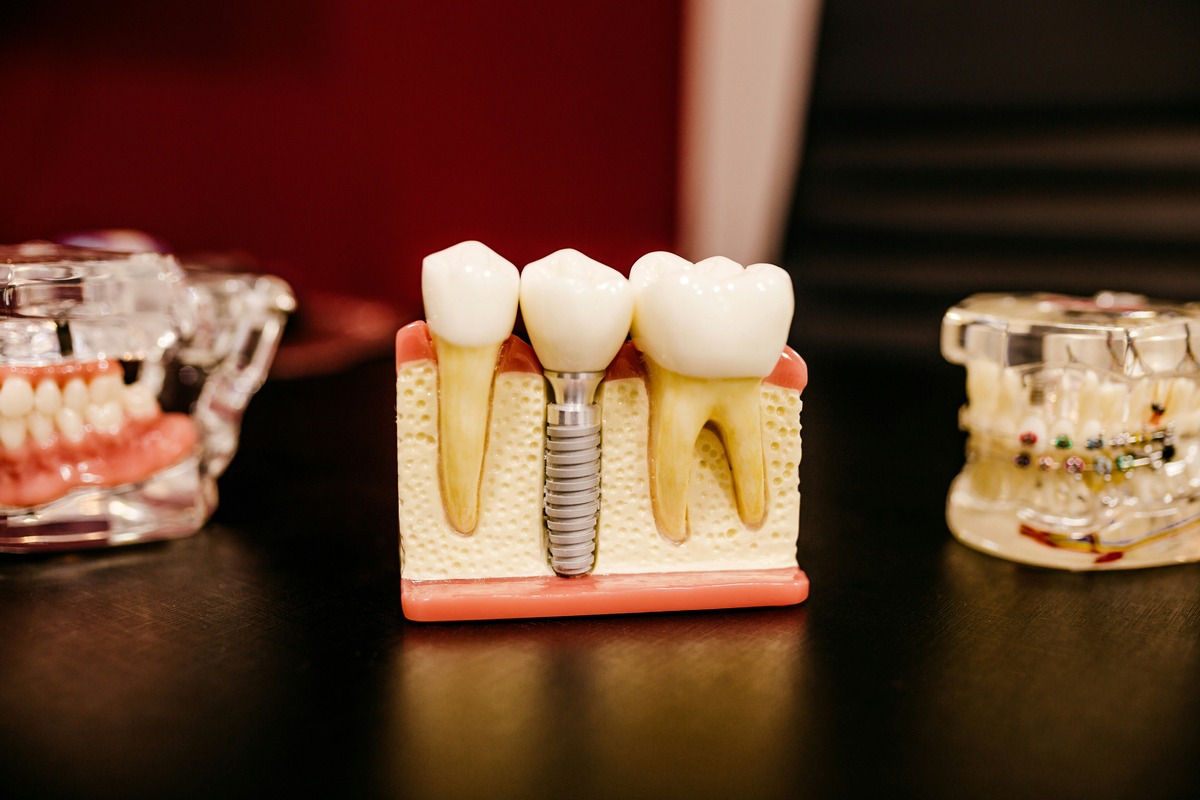Home>Health and Wellness>Unveiling The Shocking Price Tag Of A Single-Tooth Implant In The USA!


Health and Wellness
Unveiling The Shocking Price Tag Of A Single-Tooth Implant In The USA!
Published: February 16, 2024
Discover the surprising cost of a single-tooth implant in the USA! Learn about the expenses and options for this essential health and wellness procedure.
(Many of the links in this article redirect to a specific reviewed product. Your purchase of these products through affiliate links helps to generate commission for Noodls.com, at no extra cost. Learn more)
Table of Contents
Introduction
Welcome to the world of dental implants, where the quest for a perfect smile meets the reality of cost considerations. Dental implants have become a popular solution for replacing missing teeth, offering a natural-looking and long-lasting alternative to traditional dentures and bridges. However, the price tag associated with single-tooth implants can often come as a shock to many individuals seeking this dental treatment.
In this article, we will delve into the intricate world of single-tooth implants and uncover the surprising costs associated with this dental procedure. From exploring the average price of a single-tooth implant in the USA to understanding the factors that influence these costs, we will provide you with a comprehensive overview of what to expect when considering this dental treatment.
Whether you are contemplating a single-tooth implant for yourself or simply curious about the financial aspects of dental implants, this article aims to shed light on the often undisclosed expenses that come with achieving a radiant and complete smile. So, fasten your seatbelts as we embark on a journey to unveil the true price of a single-tooth implant in the USA!
The Cost of a Single-Tooth Implant
The cost of a single-tooth implant in the USA can be a significant financial investment. On average, the price for a single-tooth implant ranges from $3,000 to $4,500. This cost encompasses the entire process, including the initial consultation, surgical placement of the implant, abutment, and the crown. However, it's important to note that this is a general estimate, and the actual cost can vary based on several factors.
The initial consultation with a dental implant specialist is often the first step in the process. During this appointment, the dentist will assess the patient's oral health, take X-rays, and discuss the treatment plan. This consultation fee may range from $100 to $200, depending on the dental practice and the complexity of the case.
The surgical placement of the implant fixture into the jawbone is a crucial phase of the procedure. This surgical aspect of the treatment typically comprises a significant portion of the total cost, ranging from $1,500 to $3,000. The cost can fluctuate based on the location of the dental practice, the experience of the implant surgeon, and the specific techniques utilized during the procedure.
Following the successful integration of the implant into the jawbone, an abutment is attached to the implant, which serves as the foundation for the final crown. The abutment and the custom-made crown can collectively add another $1,500 to $2,000 to the overall cost. The materials used for the crown, such as porcelain or zirconia, can influence the final price.
It's important to recognize that the cost of a single-tooth implant is not solely determined by the materials and procedures involved. Other factors, such as the location of the dental practice, the expertise of the dental professionals, and the overall quality of care, can also impact the final price. Additionally, any necessary preparatory treatments, such as bone grafting or extractions, can contribute to the overall cost of the implant procedure.
Understanding the breakdown of costs associated with a single-tooth implant is essential for individuals considering this treatment. By gaining insight into the various components that contribute to the overall expense, patients can make informed decisions and better comprehend the financial commitment involved in achieving a restored and functional smile.
Factors Affecting the Price
The cost of a single-tooth implant is influenced by a multitude of factors that can significantly impact the overall price. Understanding these factors is crucial for individuals contemplating this dental procedure. Here are the key elements that play a pivotal role in determining the cost of a single-tooth implant:
-
Location of the Dental Practice: The geographical location of the dental practice can have a substantial impact on the price of a single-tooth implant. Dental practices situated in metropolitan areas or regions with a higher cost of living may charge more for their services compared to practices in rural or less affluent areas. This variation in pricing is reflective of the differences in overhead costs, such as rent, utilities, and labor expenses.
-
Experience and Expertise of the Dental Professionals: The level of experience and expertise of the dental professionals involved in the implant procedure can influence the overall cost. Highly skilled implant surgeons and prosthodontists who specialize in implant dentistry may command higher fees for their services due to their advanced training, specialized knowledge, and successful track record in performing implant procedures.
-
Quality of Materials and Technology: The quality of materials used in the implant procedure, including the implant fixture, abutment, and crown, can impact the cost. High-quality materials, such as medical-grade titanium for the implant fixture and durable, aesthetically pleasing crowns, may come at a higher price point. Additionally, dental practices equipped with advanced technology and state-of-the-art facilities may charge higher fees to cover the expenses associated with maintaining and utilizing cutting-edge equipment.
-
Preparatory Treatments and Additional Procedures: The need for preparatory treatments, such as bone grafting to augment the jawbone or extractions to remove damaged teeth, can contribute to the overall cost of the implant procedure. Patients requiring additional procedures to optimize the conditions for successful implant placement should anticipate these supplementary expenses when considering the total investment in a single-tooth implant.
-
Customization and Aesthetics: The level of customization and aesthetics desired by the patient can also impact the price of a single-tooth implant. Custom-made crowns that closely mimic the appearance and function of natural teeth may incur higher costs compared to standard, off-the-shelf options. Patients seeking personalized aesthetic enhancements, such as tooth color matching and contouring, should expect these preferences to influence the final price of the implant treatment.
By taking into account these influential factors, individuals can gain a comprehensive understanding of the variables that contribute to the cost of a single-tooth implant. This awareness empowers patients to make well-informed decisions and navigate the financial aspects of pursuing a single-tooth implant with clarity and confidence.
Average Cost Across Different States
The average cost of a single-tooth implant can vary significantly across different states in the USA. This regional disparity in pricing is influenced by a multitude of factors, including the cost of living, market competition, and the availability of specialized dental professionals. Understanding the average cost range across various states provides valuable insight for individuals considering a single-tooth implant and allows them to gauge the financial implications based on their geographical location.
In states with a higher cost of living and greater demand for dental services, such as California, New York, and Massachusetts, the average price for a single-tooth implant tends to be on the higher end of the spectrum. Patients in these states may expect to pay between $3,500 and $5,000 for a single-tooth implant, reflecting the elevated overhead expenses and the competitive nature of the dental industry in metropolitan areas.
On the other hand, states with a lower cost of living and a more moderate market for dental care, such as Texas, Ohio, and Tennessee, often feature a more affordable average cost for single-tooth implants. In these regions, patients may find the average price range to be between $2,500 and $3,500, making the implant procedure relatively more accessible to individuals seeking restorative dental treatments.
Furthermore, states with a strong concentration of renowned dental institutions and research facilities, such as Pennsylvania, Maryland, and Michigan, may exhibit a diverse range of pricing for single-tooth implants. The presence of academic dental centers and a robust network of dental professionals specializing in implant dentistry can contribute to a competitive pricing landscape, offering patients a spectrum of options with varying cost structures.
It is important to note that these average cost ranges are general estimates and can fluctuate based on the specific location within each state, the individual dental practice, and the unique circumstances of each patient's case. Factors such as the experience of the dental professionals, the quality of materials used, and any additional treatments required can further influence the final cost of a single-tooth implant.
By gaining insight into the average cost of single-tooth implants across different states, individuals can better comprehend the regional variations in pricing and make informed decisions when exploring their options for this dental procedure. This awareness empowers patients to navigate the financial considerations associated with single-tooth implants with a comprehensive understanding of the cost landscape in their respective states.
Additional Costs to Consider
In addition to the core expenses associated with the single-tooth implant procedure, there are several additional costs that individuals should consider when evaluating the overall financial investment in this dental treatment. Understanding these supplementary expenses is essential for comprehensive financial planning and ensures that patients are well-prepared for the full spectrum of costs involved in achieving a restored and functional smile.
-
Diagnostic Imaging: Prior to the implant procedure, diagnostic imaging, such as panoramic X-rays and 3D cone beam scans, may be necessary to assess the condition of the jawbone and surrounding structures. These imaging studies can incur additional costs, typically ranging from $100 to $500, depending on the specific imaging techniques utilized and the imaging facility.
-
Sedation or Anesthesia: For patients who opt for sedation or anesthesia during the surgical placement of the implant, there are associated costs to consider. The type of sedation, whether it's conscious sedation or general anesthesia, and the duration of sedation can influence the overall expense, which may range from $200 to $1,000.
-
Post-Operative Care and Medications: Following the implant surgery, patients may require post-operative care, including follow-up appointments, prescription medications, and specialized oral hygiene products. These post-operative care expenses should be factored into the overall budget for the implant procedure, with potential costs varying based on individual needs and recovery progress.
-
Temporary Prosthesis: In some cases, a temporary prosthesis may be necessary during the healing phase after the implant placement. The fabrication and placement of a temporary crown or bridge can result in additional costs, typically ranging from $300 to $800, depending on the complexity of the temporary restoration.
-
Long-Term Maintenance and Potential Revisions: While dental implants are designed to be durable and long-lasting, there may be long-term maintenance costs to consider, such as periodic examinations, professional cleanings, and potential prosthesis revisions over time. Patients should anticipate these ongoing maintenance expenses as part of the overall commitment to the longevity and functionality of their single-tooth implant.
-
Insurance Coverage and Financing Options: It's important to explore the extent of insurance coverage for dental implants and inquire about available financing options. While dental insurance plans may offer partial coverage for certain aspects of the implant procedure, such as diagnostic imaging or the final prosthesis, patients should be prepared for potential out-of-pocket expenses. Additionally, many dental practices provide financing plans or payment options to help individuals manage the cost of the implant treatment over time.
By taking into account these additional costs and considering the full spectrum of financial implications, individuals can approach the decision-making process regarding single-tooth implants with a comprehensive understanding of the investment involved. This proactive approach to financial planning empowers patients to make informed choices and embark on their journey to a revitalized smile with confidence and clarity.
Ways to Save on Single-Tooth Implant Costs
Navigating the financial considerations of a single-tooth implant can be a daunting prospect for many individuals. However, there are several proactive strategies and avenues to explore that can help mitigate the overall cost of this dental procedure. By leveraging these approaches, patients can make the pursuit of a restored smile more financially feasible without compromising on the quality of care.
Research and Compare Dental Practices
Conducting thorough research and comparing the pricing structures of different dental practices can yield valuable insights into the range of costs for single-tooth implants. Exploring practices in various locations and seeking recommendations from trusted sources can provide a comprehensive view of the pricing landscape. Additionally, some practices may offer promotional pricing, discounts for new patients, or financing options that can contribute to cost savings.
Explore Dental Schools and Teaching Institutions
Dental schools and teaching institutions often provide implant treatment at reduced costs, as these settings serve as learning environments for dental students and residents. Patients may have the opportunity to receive high-quality care under the supervision of experienced faculty at a fraction of the typical price. While the treatment process may take longer due to educational considerations, the potential cost savings can make this option appealing for individuals seeking affordable implant solutions.
Inquire About Flexible Payment Plans
Many dental practices offer flexible payment plans or financing options to help patients manage the cost of a single-tooth implant over time. By spreading the expense into manageable monthly installments, individuals can undergo the implant procedure without experiencing a significant financial burden upfront. Exploring these payment arrangements with the dental practice's financial coordinator can provide clarity on the available options and alleviate concerns about the immediate affordability of the treatment.
Maximize Dental Insurance Benefits
Patients with dental insurance coverage should thoroughly review their policy to understand the extent of coverage for implant procedures. While dental insurance plans may not fully cover the entire cost of a single-tooth implant, they may offer partial benefits for certain aspects of the treatment, such as diagnostic imaging, the abutment, or the final prosthesis. Maximizing the available insurance benefits can help offset a portion of the overall expense, reducing the financial impact on the individual.
Maintain Optimal Oral Health
Prioritizing and maintaining optimal oral health can contribute to long-term cost savings by reducing the likelihood of extensive dental treatments in the future. By adhering to a consistent oral hygiene routine, attending regular dental check-ups, and addressing any dental issues promptly, individuals can minimize the risk of additional dental problems that may necessitate costly interventions. Preventive care and proactive oral health management can ultimately lead to reduced long-term dental expenses.
Seek Consultations and Second Opinions
Obtaining consultations and seeking second opinions from multiple dental professionals can provide valuable perspectives on treatment options and associated costs. Exploring different approaches and treatment plans can help individuals make informed decisions while potentially uncovering more cost-effective alternatives. Additionally, some practices may offer complimentary or discounted initial consultations, allowing patients to gather comprehensive information without incurring substantial upfront expenses.
By embracing these proactive strategies and exploring the available avenues for cost savings, individuals can approach the prospect of a single-tooth implant with greater financial confidence. While the investment in a restored smile is significant, leveraging these approaches can make the pursuit of dental implants more accessible and financially manageable, ultimately leading to a brighter and more confident smile for those seeking this transformative dental solution.
Conclusion
In conclusion, the journey to uncover the true price of a single-tooth implant in the USA has revealed a multifaceted landscape of costs, considerations, and opportunities for individuals seeking this transformative dental treatment. The financial investment in a single-tooth implant encompasses not only the core expenses of the implant procedure itself but also a spectrum of additional costs and influential factors that shape the overall price tag. From the surgical placement of the implant fixture to the customization of the final crown, the cost of a single-tooth implant reflects the intricate blend of clinical expertise, materials, and patient-specific needs.
The factors influencing the price of a single-tooth implant, including the location of the dental practice, the experience of the dental professionals, and the quality of materials and technology, underscore the nuanced nature of cost considerations in implant dentistry. Understanding these influential elements empowers individuals to approach the decision-making process with clarity and insight, enabling them to navigate the financial aspects of pursuing a single-tooth implant with confidence.
Furthermore, the regional variations in average implant costs across different states highlight the importance of considering geographical factors when evaluating the financial implications of this dental procedure. By gaining awareness of the average cost range in their respective states, individuals can make informed comparisons and strategic decisions regarding their options for single-tooth implants, aligning their financial planning with the regional pricing landscape.
Moreover, the exploration of additional costs associated with single-tooth implants, such as diagnostic imaging, post-operative care, and potential long-term maintenance, underscores the comprehensive nature of financial planning required for this dental treatment. By acknowledging and preparing for these supplementary expenses, patients can approach the implant journey with a holistic understanding of the full spectrum of costs involved.
Finally, the proactive strategies and avenues to save on single-tooth implant costs offer individuals practical approaches to make the pursuit of a restored smile more financially feasible. From researching and comparing dental practices to maximizing dental insurance benefits, these strategies empower patients to navigate the financial considerations of single-tooth implants with resourcefulness and determination.
In essence, the true price of a single-tooth implant in the USA encompasses not only the monetary investment but also the potential for a renewed sense of confidence, functionality, and well-being. By embracing a comprehensive understanding of the costs, factors, and opportunities associated with single-tooth implants, individuals can embark on their journey to a revitalized smile with informed decision-making and financial empowerment.













